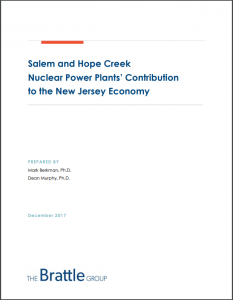Full Title: Salem and Hope Creek Nuclear Power Plants’ Contribution to the New Jersey Economy
Author(s): Mark Berkman & Dean Murphy
Publisher(s): The Brattle Group
Publication Date: December 1, 2017
Full Text: Download Resource
Description (excerpt):
In recent years, wholesale electricity prices have declined significantly, due in large part to the shale gas revolution. Natural gas is the price-setting fuel in many U.S. electricity markets, and the dramatic reduction in its price has brought down electricity prices as well. Negligible demand growth and substantial amounts of new policy-driven renewable generation have also contributed. While lower power prices are generally a positive development for consumers, persistently low prices can threaten the economic viability of existing generators, whose premature retirement could offset much of the price reductions that have occurred. Nuclear generators in particular, because of their high fixed costs and effectively zero variable costs, tend to keep market prices low when they are operating, but are themselves financially vulnerable to sustained low power prices. Indeed, in the past few years, several nuclear plants have been retired prematurely for purely economic reasons, and a number of others are threatened. Because of the economic and environmental consequences that accompany the loss of nuclear generation, some states have implemented and others are considering policy mechanisms that would support existing nuclear power plants and prevent their premature retirement.
In this context, The Brattle Group has evaluated the contribution that the Salem and Hope Creek nuclear power plants in New Jersey make to the state’s economy. We considered how these plants affect electricity markets and prices as well as in-state productive activity, and studied the resulting ramifications of these factors throughout the New Jersey economy. We found that these plants keep electricity prices lower than they would otherwise be, and also keep productive economic activity in-state. As a result, New Jersey’s GDP will be higher with these plants operating than it would be without them. These plants also maintain jobs within New Jersey; not only the direct employees of the plants and the indirect jobs at suppliers and contractors that support plant operations, but also additional jobs throughout the economy that result from the overall economic boost associated with lower electricity prices and more in-state production. In addition, the continued operation of these nuclear plants holds down emissions of CO2 and other air pollutants both within and outside New Jersey. In their absence, correspondingly more power would be produced by fossil-fueled power plants, causing a substantial increase in emissions.
In this analysis, we have not considered the structure or cost of any potential policy mechanism that may be necessary to ensure the continued operation of these nuclear plants. As a result, this analysis effectively calculates the gross economic benefits of preserving these plants, not the net benefit of a proposed policy that would do so.
